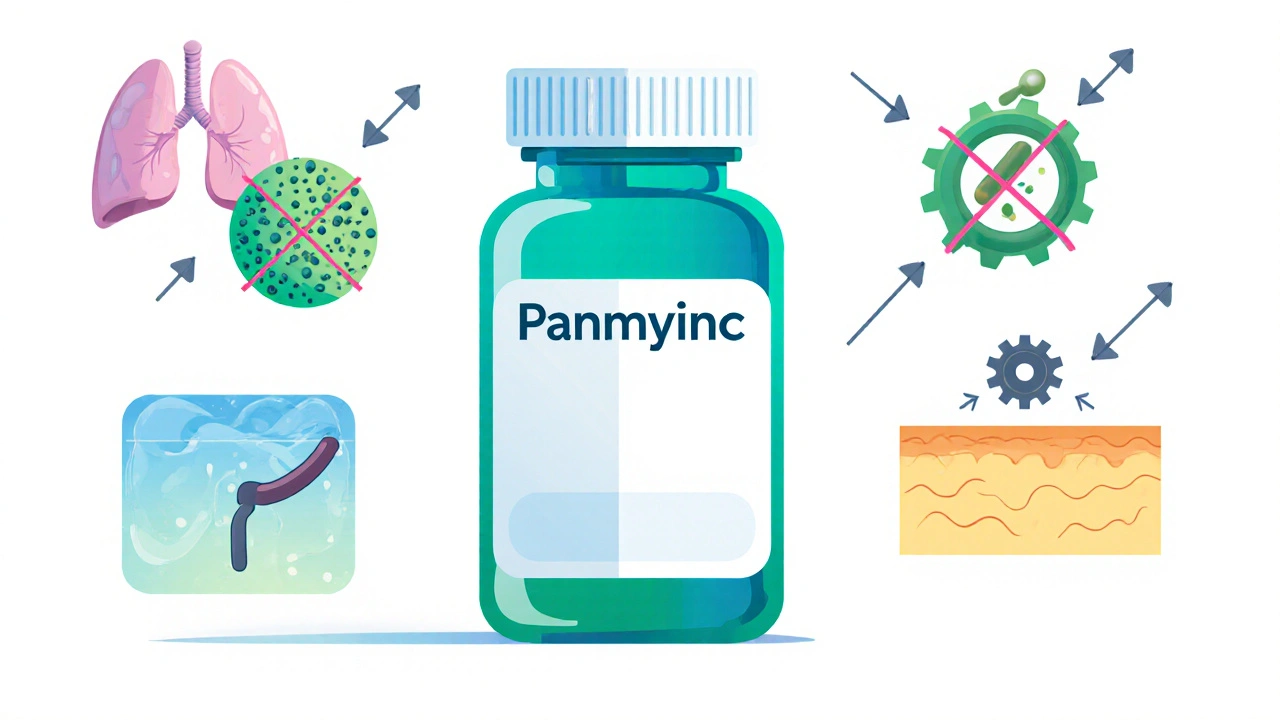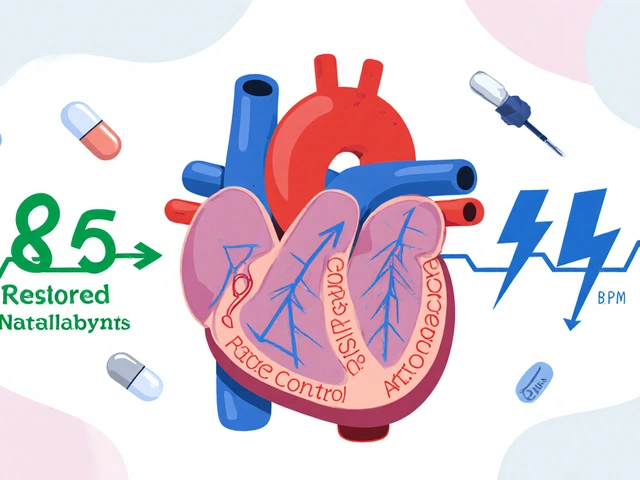Antibiotic Selector Tool
Select Your Situation
Quick Summary
This guide breaks down Panmycin (a tetracycline) against four common alternatives-Doxycycline, Minocycline, generic Tetracycline, and Azithromycin-covering spectrum, dosing, side‑effects and pregnancy safety so you can pick the right pill for the infection you face.
What is Panmycin?
Panmycin is a brand name for a broad‑spectrum tetracycline antibiotic that inhibits bacterial protein synthesis by binding to the 30S ribosomal subunit. It was first approved in the UK in the early 2000s and is often prescribed for respiratory, urinary and skin infections.
How Tetracycline Antibiotics Work
All drugs in the tetracycline class, including Panmycin, share a common mechanism: they block the attachment of tRNA to the ribosome, halting the production of essential proteins. This stops bacteria from multiplying, giving the immune system a chance to clear the infection.
Key characteristics of tetracyclines:
- Effective against both Gram-positive bacteria and Gram-negative bacteria
- Oral absorption is good, but calcium‑rich foods can reduce bioavailability
- Can cause photosensitivity, so sun protection is a must
Alternatives to Panmycin
When a doctor looks beyond Panmycin, the most common picks are other tetracyclines-Doxycycline and Minocycline-as well as a non‑tetracycline macrolide, Azithromycin. Below is a quick rundown of each.
Side‑by‑Side Comparison
| Antibiotic | Class | Typical Use Cases | Dosing Frequency | Common Side Effects | Pregnancy Category (US) |
|---|---|---|---|---|---|
| Panmycin | Tetracycline | Upper resp. infections, uncomplicated UTIs, acne | Every 6hours | Upset stomach, photosensitivity, teeth discoloration (long‑term) | D (risk outweighs benefit) |
| Doxycycline | Tetracycline | Lyme disease, acne, travel‑related diarrhoea, malaria prophylaxis | Every 12hours | Nausea, esophagitis, photosensitivity (less severe) | D (use only if clearly needed) |
| Minocycline | Tetracycline | Acne, rheumatoid arthritis adjunct, certain STIs | Every 12hours | Dizziness, autoimmune‑type reactions, vestibular side‑effects | D (avoid in pregnancy) |
| Azithromycin | Macrolide | Community‑acquired pneumonia, chlamydia, sinusitis | Once daily for 3‑5days | Diarrhoea, QT prolongation (rare) | B (generally safer in pregnancy) |
When to Choose Panmycin
If you need a drug with a proven track record against a wide range of bacteria and you can manage the four‑times‑daily schedule, Panmycin remains a solid go‑to. It’s especially handy when the infection is known to involve both gram‑positive and gram‑negative strains, because its spectrum is broader than many newer agents.
However, remember the FDA warns that tetracyclines cross the placenta and can affect fetal bone growth. For pregnant patients or young children, you’ll often see doctors pivot to Azithromycin or a beta‑lactam instead.
Why Doxycycline Might Be Better
Doxycycline offers a simpler twice‑daily dosing, which improves adherence. It also has a longer half‑life, meaning the drug stays in the system longer-great for travel‑related infections where you need steady coverage.
Its side‑effect profile is milder when it comes to dental staining, making it preferable for longer courses.
When Minocycline Shines
Minocycline’s lipophilicity lets it penetrate skin and joint tissue better, so dermatologists love it for severe acne and rheumatologists sometimes add it to anti‑inflammatory regimens. The trade‑off is a higher chance of dizziness or vestibular issues, so patients should avoid driving until they know how they react.
Azithromycin: The Non‑Tetracycline Option
Azithromycin is a macrolide, not a tetracycline, so it works by blocking bacterial protein synthesis at a different site. This means it can be effective against some tetracycline‑resistant strains. Its once‑daily dosing over a short course is a huge convenience factor, and its pregnancy category B makes it the safer choice for expectant mothers.
The downside? It’s not as broad‑spectrum as Panmycin, so you need a clear indication that the likely pathogen is susceptible.

Safety Tips and Contra‑indications
Across all tetracyclines, keep these rules in mind:
- Take on an empty stomach (one hour before or two hours after meals) to maximise absorption.
- Avoid dairy, antacids or iron supplements within two hours of the dose.
- Use sunscreen or wear protective clothing - photosensitivity is real.
- Do not use during the second and third trimesters of pregnancy or in children under eight years old unless absolutely necessary.
Azithromycin has its own cautions: watch for heart rhythm changes if you’re on other QT‑prolonging drugs.
How to Decide the Right Antibiotic for You
Think of choosing an antibiotic like picking the right tool for a job. Ask yourself:
- What bacteria am I likely dealing with? (Gram‑positive, Gram‑negative, atypical?)
- Do I need a long course or a short burst?
- Am I pregnant, nursing, or caring for a child?
- Can the patient stick to a multiple‑times‑daily schedule?
- Are there known allergies or previous resistance issues?
Answering these questions with your doctor will usually point you toward Panmycin, Doxycycline, Minocycline or Azithromycin.
Frequently Asked Questions
Can I take Panmycin with food?
No. Food, especially dairy, can cut absorption by up to 50%. Take it on an empty stomach for best results.
How does Doxycycline differ in side‑effects?
Doxycycline still causes photosensitivity, but it’s less likely to stain teeth during short courses. It also has a lower risk of gut upset.
Is Azithromycin safe in the first trimester?
Yes. In the US it’s classified as Category B, meaning animal studies show no risk and there are no well‑controlled studies in pregnant women, but doctors still weigh benefits against unknowns.
Can I switch from Panmycin to Doxycycline midway?
Only under medical supervision. The two drugs have similar mechanisms, but dosage and treatment length differ, so a doctor should confirm the switch.
What should I do if I develop a rash while on any tetracycline?
Stop the medication immediately and contact your healthcare provider. A rash could signal an allergic reaction that needs prompt attention.
Bottom Line
Panmycin remains a reliable, broad‑spectrum option when you can handle the four‑times‑daily dosing and aren’t pregnant. Doxycycline offers easier dosing and fewer dental concerns, Minocycline penetrates skin and joints better, while Azithromycin provides a short, once‑daily course and a safer pregnancy profile. Talk to your doctor about the infection type, lifestyle and any special health considerations, and you’ll land on the antibiotic that fits your situation best.



 Medications
Medications





Lauren Sproule
October 17, 2025 AT 17:04Great rundown I love how u kept it simple and clear
Malia Rivera
October 26, 2025 AT 22:17When we talk about antibiotics we’re really wrestling with the balance between individual liberty and collective health, a concept that resonates deeply with any proud American who values both personal freedom and the common good. The tetracycline family, especially Panmycin, showcases how a single class can dominate the market, but dominance isn’t always synonymous with superiority. Think about the historical context-our nation's pharmaceutical advancements have always been rooted in the relentless pursuit of strength, and that translates into preferring broad‑spectrum agents when the situation calls for it. Yet, the practicalities of four‑times‑daily dosing can erode adherence, which is a subtle form of self‑sabotage that undermines the very freedom we cherish. In short, Panmycin is a powerful tool, but like any tool, it must be wielded wisely, lest we compromise the very values we hold dear.
Cindy Thomas
November 5, 2025 AT 04:30Honestly, the table makes it look like Panmycin is the jack‑of‑all‑trades, but the side‑effect profile says otherwise :) While doxycycline is easier on the stomach and less likely to cause teeth staining, it still carries photosensitivity, so sunscreen isn’t optional. And yes, azithromycin’s once‑daily dosing is a convenience perk, not a magic bullet. Keep in mind that “broad‑spectrum” doesn’t automatically mean “best choice” – it’s all about matching the drug to the pathogen and patient circumstances.
Kate Marr
November 14, 2025 AT 10:44As a proud 🇺🇸 citizen, I’ve seen how our medical system has to adapt, and the convenience of azithromycin’s short course is a real game‑changer 🚀. Still, if you need that heavy‑duty coverage for mixed infections, Panmycin’s breadth can’t be ignored 💊. Just remember to avoid dairy around dosing to keep absorption up. #StayInformed
James Falcone
November 23, 2025 AT 16:57Four times a day? That’s a lot of pills, bro.
Frank Diaz
November 30, 2025 AT 15:37While you romanticize the “American spirit” of tackling infections head‑on, you overlook the pharmacokinetic reality that a drug’s half‑life dictates adherence more than patriotism ever could. Panmycin’s four‑daily schedule inevitably leads to missed doses, which breeds resistance – a risk no nationalist can afford to ignore.
Mary Davies
December 9, 2025 AT 21:50I’ve always wondered whether the “broad‑spectrum” label is just a marketing buzzword or a genuine clinical advantage, especially when patients juggle busy lives and strict dosing schedules. The drama of an infection flashing across the body, needing an antibiotic that can hit every corner, is compelling, yet the reality of side‑effects like photosensitivity adds a theatrical twist to the treatment journey.
Virginia Dominguez Gonzales
December 13, 2025 AT 09:10Never doubt that you can find the right balance – think of your treatment plan as a choreography where every step matters. If Panmycin feels like a demanding partner, consider switching to doxycycline for its smoother rhythm, or even azithromycin if you need a quick solo. Remember, consistency beats intensity; setting alarms and pairing your dose with a glass of water can turn a chaotic routine into a confident performance. You’ve got this, and your health deserves the spotlight.